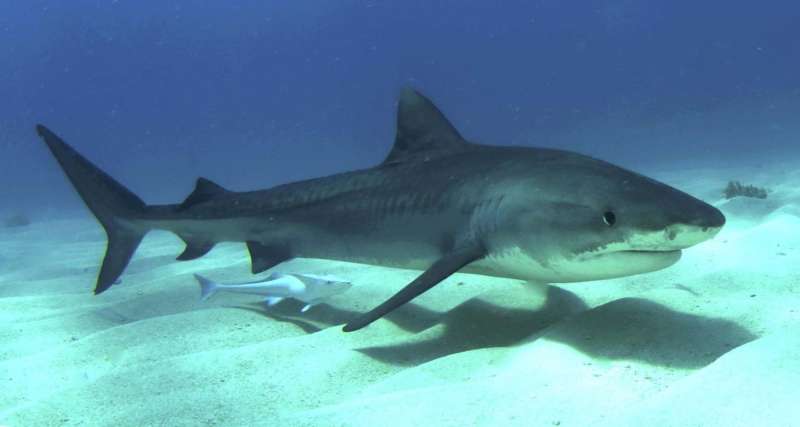Why do sharks dive?

Is it to regulate their body temperature? Conserve energy? Find food?
Tiger sharks at Ningaloo Reef are thought to search the seafloor for prey as they dive down and scan for silhouettes as they swim up to the surface.
But could there be other reasons why the sharks continuously move up and down through the water column?
That's what UWA student Sammy Andrzejaczek is hoping to find out for her Ph.D. research.
Sammy captured 24 tiger sharks at Ningaloo Reef and attached tracking devices to them for up to 48 hours.
Best described as Fitbits for sharks, the devices recorded activity rates and other data 20 times a second.
"I can even look at each individual tail beat," Sammy says.
"It helps us understand why they move the way they do, how environmental change might impact their movements and how removal of prey species from the water column may affect their movement."
Caught On Camera
The tags also contained video cameras, so Sammy could see the habitats the sharks moved through and the animals they encountered.
She watched how the sharks reacted to prey and how the prey reacted to the sharks.
Spoiler alert: Tiger sharks can be pretty lazy—Sammy says something as simple as a turtle noticing a shark and turning away could cause the shark not to bother hunting the turtle down.
"It's all the interactions that are happening on a daily basis that we don't actually usually see," Sammy says.
"Because if you put a human in the water, it's not a natural system any more."
"We get the daily life of a tiger shark without having to distract it from its normal routine."
Spam And Nails
Sammy says tiger sharks feed on just about everything.
"Stomach content analysis has found their normal prey items, such as turtles and rays and fish," she says.
"But they've also found some really interesting things, such as licence plates, cans of spam and nails."
"So they've got a very broad diet."
Tiger sharks may search for food as they move up and down through the water column, Sammy says.
"On the way down, they're scanning the seabed for prey," she says.
"And then on the way, up they're searching for silhouettes of prey at the surface."
Ningaloo's top predators
Sammy says studying top predators like sharks can help us understand the ecosystem as a whole.
How tiger sharks move through Ningaloo Reef and feed can help us figure out how they might be impacting the animals beneath them in the food chain, she says.
But hours of watching tiger sharks hunt hasn't put Sammy off the animals at all.
She says her time tagging sharks at Ningaloo was the best month of her Ph.D., if not her life.
"At first, I was a bit apprehensive about it … getting that close to some very big animals," Sammy says.
"But they were very chilled once you had them restrained alongside the boat."
"They'd just sit there, you'd attach the tag, you'd take the line off and they'd just swim off really calmly, it was pretty amazing to see. They're just absolutely beautiful animals."
Provided by Particle
This article first appeared on Particle, a science news website based at Scitech, Perth, Australia. Read the original article.


















